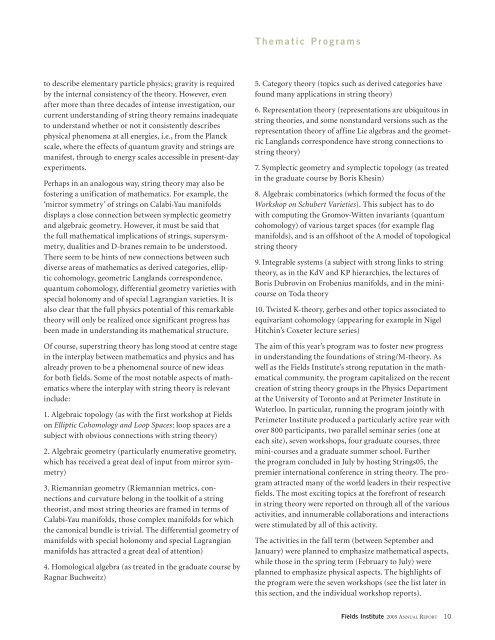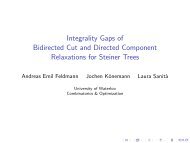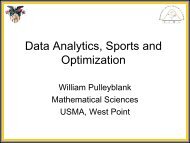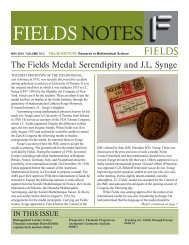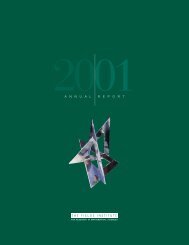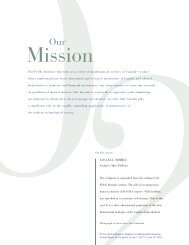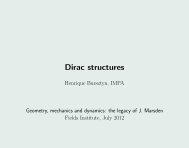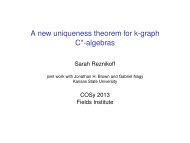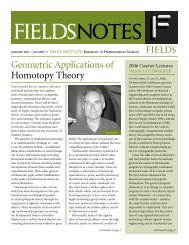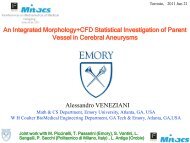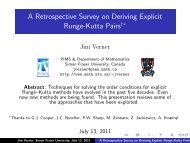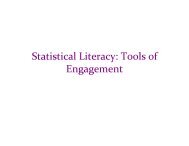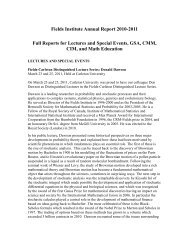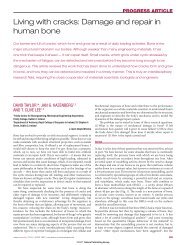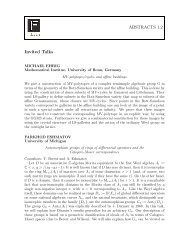Annual Report 2005 - Fields Institute - University of Toronto
Annual Report 2005 - Fields Institute - University of Toronto
Annual Report 2005 - Fields Institute - University of Toronto
You also want an ePaper? Increase the reach of your titles
YUMPU automatically turns print PDFs into web optimized ePapers that Google loves.
to describe elementary particle physics; gravity is required<br />
by the internal consistency <strong>of</strong> the theory. However, even<br />
after more than three decades <strong>of</strong> intense investigation, our<br />
current understanding <strong>of</strong> string theory remains inadequate<br />
to understand whether or not it consistently describes<br />
physical phenomena at all energies, i.e., from the Planck<br />
scale, where the effects <strong>of</strong> quantum gravity and strings are<br />
manifest, through to energy scales accessible in present-day<br />
experiments.<br />
Perhaps in an analogous way, string theory may also be<br />
fostering a unification <strong>of</strong> mathematics. For example, the<br />
‘mirror symmetry’ <strong>of</strong> strings on Calabi-Yau manifolds<br />
displays a close connection between symplectic geometry<br />
and algebraic geometry. However, it must be said that<br />
the full mathematical implications <strong>of</strong> strings, supersymmetry,<br />
dualities and D-branes remain to be understood.<br />
There seem to be hints <strong>of</strong> new connections between such<br />
diverse areas <strong>of</strong> mathematics as derived categories, elliptic<br />
cohomology, geometric Langlands correspondence,<br />
quantum cohomology, differential geometry varieties with<br />
special holonomy and <strong>of</strong> special Lagrangian varieties. It is<br />
also clear that the full physics potential <strong>of</strong> this remarkable<br />
theory will only be realized once significant progress has<br />
been made in understanding its mathematical structure.<br />
Of course, superstring theory has long stood at centre stage<br />
in the interplay between mathematics and physics and has<br />
already proven to be a phenomenal source <strong>of</strong> new ideas<br />
for both fields. Some <strong>of</strong> the most notable aspects <strong>of</strong> mathematics<br />
where the interplay with string theory is relevant<br />
include:<br />
1. Algebraic topology (as with the first workshop at <strong>Fields</strong><br />
on Elliptic Cohomology and Loop Spaces: loop spaces are a<br />
subject with obvious connections with string theory)<br />
2. Algebraic geometry (particularly enumerative geometry,<br />
which has received a great deal <strong>of</strong> input from mirror symmetry)<br />
3. Riemannian geometry (Riemannian metrics, connections<br />
and curvature belong in the toolkit <strong>of</strong> a string<br />
theorist, and most string theories are framed in terms <strong>of</strong><br />
Calabi-Yau manifolds, those complex manifolds for which<br />
the canonical bundle is trivial. The differential geometry <strong>of</strong><br />
manifolds with special holonomy and special Lagrangian<br />
manifolds has attracted a great deal <strong>of</strong> attention)<br />
4. Homological algebra (as treated in the graduate course by<br />
Ragnar Buchweitz)<br />
T h e m a t i c P r o g r a m s<br />
5. Category theory (topics such as derived categories have<br />
found many applications in string theory)<br />
6. Representation theory (representations are ubiquitous in<br />
string theories, and some nonstandard versions such as the<br />
representation theory <strong>of</strong> affine Lie algebras and the geometric<br />
Langlands correspondence have strong connections to<br />
string theory)<br />
7. Symplectic geometry and symplectic topology (as treated<br />
in the graduate course by Boris Khesin)<br />
8. Algebraic combinatorics (which formed the focus <strong>of</strong> the<br />
Workshop on Schubert Varieties). This subject has to do<br />
with computing the Gromov-Witten invariants (quantum<br />
cohomology) <strong>of</strong> various target spaces (for example flag<br />
manifolds), and is an <strong>of</strong>fshoot <strong>of</strong> the A model <strong>of</strong> topological<br />
string theory<br />
9. Integrable systems (a subject with strong links to string<br />
theory, as in the KdV and KP hierarchies, the lectures <strong>of</strong><br />
Boris Dubrovin on Frobenius manifolds, and in the minicourse<br />
on Toda theory<br />
10. Twisted K-theory, gerbes and other topics associated to<br />
equivariant cohomology (appearing for example in Nigel<br />
Hitchin’s Coxeter lecture series)<br />
The aim <strong>of</strong> this year’s program was to foster new progress<br />
in understanding the foundations <strong>of</strong> string/M-theory. As<br />
well as the <strong>Fields</strong> <strong>Institute</strong>’s strong reputation in the mathematical<br />
community, the program capitalized on the recent<br />
creation <strong>of</strong> string theory groups in the Physics Department<br />
at the <strong>University</strong> <strong>of</strong> <strong>Toronto</strong> and at Perimeter <strong>Institute</strong> in<br />
Waterloo. In particular, running the program jointly with<br />
Perimeter <strong>Institute</strong> produced a particularly active year with<br />
over 800 participants, two parallel seminar series (one at<br />
each site), seven workshops, four graduate courses, three<br />
mini-courses and a graduate summer school. Further<br />
the program concluded in July by hosting Strings05, the<br />
premier international conference in string theory. The program<br />
attracted many <strong>of</strong> the world leaders in their respective<br />
fields. The most exciting topics at the forefront <strong>of</strong> research<br />
in string theory were reported on through all <strong>of</strong> the various<br />
activities, and innumerable collaborations and interactions<br />
were stimulated by all <strong>of</strong> this activity.<br />
The activities in the fall term (between September and<br />
January) were planned to emphasize mathematical aspects,<br />
while those in the spring term (February to July) were<br />
planned to emphasize physical aspects. The highlights <strong>of</strong><br />
the program were the seven workshops (see the list later in<br />
this section, and the individual workshop reports).<br />
<strong>Fields</strong> <strong>Institute</strong> <strong>2005</strong> ANNUAL REPORT 10


